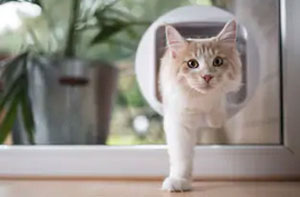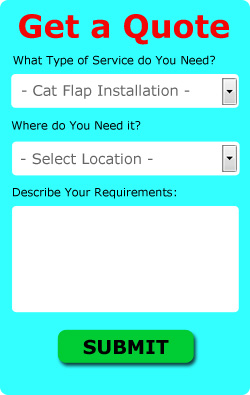Cat Flap Fitters
Cat Flaps and Cat Flap Installation
Cat flaps are a practical solution for giving your feline friend the freedom to come and go as they please. They're a simple yet effective addition to any home, allowing your cat to enjoy the outdoors while giving you peace of mind. For many cat owners, installing a cat flap is a must, especially if your pet is used to spending time outside. Whether it's a basic flap or one with more advanced features like microchip technology, the right cat flap can make life easier for both you and your pet.
Choosing the right type of cat flap is an important first step. There are many varieties available, from traditional manual flaps to high-tech models that only open for your pet. Manual cat flaps are often the most affordable option and work well for cats that are free to come and go at any time. However, if you live in an area with a lot of wildlife or other neighbourhood pets, you might want to consider a cat flap with added security features. Microchip cat flaps, for example, will only unlock for your cat, preventing unwanted visitors from entering your home.
Another factor to consider when choosing a cat flap is the size of your pet. While standard cat flaps are suitable for most cats, larger breeds or cats carrying a bit of extra weight might need a larger flap to ensure they can pass through comfortably. It's always best to measure your cat and compare this to the size of the flap opening before making a purchase. You want your cat to feel comfortable using the flap, so size really does matter.
Once you've chosen the right cat flap, the next step is deciding where to install it. Many people opt to fit their cat flap in a back door, but this isn't the only option. Cat flaps can be installed in doors, walls, and even glass. The type of installation will depend on your home's layout and the materials involved. For example, fitting a cat flap into a wooden door is relatively straightforward, while installing one in a glass door or a wall requires more skill and precision.
For those fitting a cat flap into a wooden or uPVC door, the process is often manageable for a competent DIYer. The first step is marking the position of the flap and cutting out a hole in the door that matches the size of the cat flap. You'll need a jigsaw or similar tool to create the opening, followed by carefully securing the flap into place. Once installed, the flap should be checked to ensure it swings freely and your cat can easily pass through.
If you're planning to install a cat flap into a glass door, the process is more complex. Glass, particularly double-glazed glass, cannot be easily cut without specialist tools, so it's often necessary to hire a professional glazier to handle the job. A new pane of glass with a pre-cut hole is usually required, ensuring that the integrity of the door is maintained and the flap is installed securely. While this option can be more expensive than installing a flap in a wooden door, it ensures a professional finish without compromising the thermal efficiency of the door.

Wall installation is another option, particularly for homes where a door installation isn't practical. Installing a cat flap in a wall is a more involved process, often requiring a tunnel to be created through the wall for your cat to pass through. This option provides a discreet solution, particularly in homes with modern glass doors where the aesthetics might be compromised by adding a cat flap. However, due to the complexity of cutting through walls, it's highly recommended to seek professional help for this type of installation.
No matter where you decide to install the cat flap, professional installation is always an option to consider. While some DIYers may feel comfortable tackling a basic installation, the more complex jobs – such as glass or wall installations – are best left to the experts. Professional installers have the right tools and experience to ensure the flap is fitted correctly, without causing damage to your property. A professional job will also ensure the flap is well sealed, preventing draughts and keeping your home energy-efficient.
Once the cat flap is installed, your cat will need to get used to using it. While some cats take to it straight away, others may be hesitant at first. Encouraging your cat to explore the flap, perhaps using treats or toys, can help them gain confidence in using it. For cats that are new to the idea, leaving the flap open for the first few days can help them understand how it works. Once they've mastered it, you'll find your cat enjoying their new-found freedom, without needing your constant assistance to open the door.
Maintenance of the cat flap is minimal but important for ensuring it continues to function properly. Regularly cleaning the flap to remove dirt, fur, or other debris will keep it swinging freely. It's also a good idea to periodically check the seals, especially if you live in an area prone to cold weather, as draughts can develop over time. If you have a cat flap with electronic features, such as a microchip reader, replacing the batteries as needed will ensure it continues to work correctly.
http://www.catflapfitter.uk/harworth.html
http://www.catflapfitter.uk/keyworth.html
http://www.catflapfitter.uk/nuthall.html
http://www.catflapfitter.uk/oswaldtwistle.html
http://www.catflapfitter.uk/brierfield.html
http://www.catflapfitter.uk/farington.html
http://www.catflapfitter.uk/preesall.html
http://www.catflapfitter.uk/earby.html
http://www.catflapfitter.uk/culcheth.html
http://www.catflapfitter.uk/blacon.html
http://www.catflapfitter.uk/midsomer-norton.html
http://www.catflapfitter.uk/cheslyn-hay.html
http://www.catflapfitter.uk/branston.html
http://www.catflapfitter.uk/tunstall.html
http://www.catflapfitter.uk/essington.html
http://www.catflapfitter.uk/epworth.html
http://www.catflapfitter.uk/winterton.html
http://www.catflapfitter.uk/market-rasen.html
http://www.catflapfitter.uk/burgh-le-marsh.html
http://www.catflapfitter.uk/countesthorpe.html
http://www.catflapfitter.uk/castle-donington.html
http://www.catflapfitter.uk/brandon.html
http://www.catflapfitter.uk/billing.html
http://www.catflapfitter.uk/olney.html
http://www.catflapfitter.uk/milnrow.html
http://www.catflapfitter.uk/cadishead.html
http://www.catflapfitter.uk/aspull.html
http://www.catflapfitter.uk/hattersley.html
http://www.catflapfitter.uk/adwick-le-street.html
http://www.catflapfitter.uk/stainforth.html
http://www.catflapfitter.uk/ouston.html
http://www.catflapfitter.uk/eynsham.html
In summary, cat flaps provide a simple, practical solution for pet owners, allowing their cats to move freely between the indoors and outdoors. With a variety of types and sizes available, there's a cat flap to suit every home and cat. While installation can vary in complexity depending on where you choose to fit the flap, the convenience it offers makes it well worth the effort. Whether you opt for a basic manual flap or a high-tech microchip model, a well-installed cat flap is sure to make both you and your cat's life easier. Employing a professional cat flap fitter is always preferable to DIY installation, if you are in any doubt about the process.
Cat Flap Fitters in Bedfordshire: Stotfold, Shefford, Arlesey, Cranfield, Barton le Clay, Potton, Bromham, Toddington, Clapham, Eaton Bray, Lower Stondon, Marston Moretaine, Wootton, Caddington, Langford, Fairfield Park, Oakley, Shortstown, Clophill, Maulden, Clifton, Harlington, Henlow, Wilstead, Westoning, Great Barford, Sharnbrook, Silsoe, Meppershall, Harrold, Kensworth, Shillington, Billington, Chicksands, Slip End, Heath and Reach, Houghton Conquest, Riseley, Upper Caldecote, Stewartby, Lidlington, Totternhoe, Blunham, Turvey, Haynes, Woburn, Carlton, Cotton End, Hockliffe, Beeston, Linslade, Flitwick, Biddenham, Northill, Wilshamstead, Aspley Guise, Elstow, Stondon, Streatley, Renhold, Campton, Roxton, Flitton, Greenfield, Southill, Studham, Wymington, Pulloxhill, Luton, Bedford, Dunstable, Leighton Buzzard, Biggleswade, Houghton Regis, Sandy, Kempston, Ampthill, Barton-le-Clay. You should have no problem getting cat flap fitters in all of these Bedfordshire places.
Magnetic Cat Flaps
Magnetic cat flaps are an excellent option for homeowners who want to provide their cat with outdoor access while adding an extra layer of security. Unlike standard flaps that any animal can push open, magnetic cat flaps use a small magnet attached to your cat's collar to unlock the door. This means that only your cat, equipped with the special collar, can come and go through the flap, preventing other animals or even neighbourhood cats from entering your home.
The key advantage of magnetic cat flaps is that they offer greater control over which animals can access your home. If you live in an area where stray cats or wildlife are common, this feature can be invaluable. By ensuring that only your cat can use the flap, you minimise the risk of unwelcome visitors, which can help protect both your home and your pet. Additionally, this can reduce the chances of other animals bringing dirt, fleas, or other pests into your home.
Installing a magnetic cat flap follows a similar process to other types of flaps, whether you're fitting it into a door, wall, or glass. However, there are a few extra steps involved when setting up the magnetic locking mechanism. The flap itself will be fitted with a magnet or magnetic sensor, and your cat will need to wear a collar with the corresponding magnetic key. Once the collar is in place, the flap will unlock when your cat approaches, allowing them to push through with ease. When your cat moves away, the flap locks again, preventing any other animals from entering.
One of the concerns that pet owners sometimes have with magnetic cat flaps is the requirement for their cat to wear a collar. Not all cats are used to wearing collars, and some may resist at first. However, most cats quickly adjust to wearing a collar, especially if it's lightweight and comfortable. It's important to choose a breakaway collar with a safety release mechanism, ensuring that your cat can free themselves if the collar gets caught on anything.
Magnetic cat flaps also tend to be more affordable than more advanced models, such as microchip-activated flaps, while still offering a significant upgrade in terms of security compared to traditional manual flaps. This makes them an attractive option for pet owners looking for a balance between cost and functionality. They are also relatively low-maintenance, with no need for batteries or power, making them a reliable and convenient choice.
In terms of maintenance, magnetic cat flaps are fairly simple to care for. Regular cleaning around the edges of the flap will ensure the magnetic mechanism continues to work smoothly, and checking the collar magnet from time to time will help to avoid any issues with wear and tear. As with any cat flap, ensuring the seals around the flap are secure will help prevent draughts and keep your home energy efficient.
Overall, magnetic cat flaps provide a secure, convenient, and affordable solution for cat owners who want to control access to their home while giving their pet the freedom to explore the outdoors. The added security of a magnetic locking system ensures that only your cat can use the flap, keeping unwanted animals out. For many pet owners, this simple technology strikes the perfect balance between functionality, cost, and peace of mind
Cat flap fitters in other areas: Cat Flap Specialists, Cat Flap Installation, Cat Flaps, Cat Flap Experts, Cat Flap Experts, Cat Flap Specialists, Cat Flap Fitters, Cat Flaps, Cat Flap Installation, Cat Flap Fitters, Cat Flap Installation, Cat Flap Installers, Cat Flap Specialists, Cat Flaps, Cat Flap Experts, Cat Flaps, Cat Flap Installation, Cat Flap Installation, Cat Flaps, Cat Flap Installers, Cat Flap Installers, Cat Flap Experts, Cat Flap Specialists, Cat Flaps, Cat Flap Experts, Cat Flap Specialists, Cat Flap Specialists, Cat Flap Installation, Cat Flap Fitting, Cat Flap Installation, Cat Flaps, Cat Flap Fitting, Cat Flap Installation, Cat Flap Fitters, Cat Flap Installation, Cat Flap Installation, Cat Flap Fitters, Cat Flap Fitting, Cat Flap Installation, Cat Flap Fitting, Cat Flap Fitting, Cat Flap Fitters, Cat Flap Experts.
Counties: Bedfordshire - Berkshire - Buckinghamshire - Cambridgeshire - Cheshire - Cornwall - County Durham - Cumbria - Derbyshire - Devon - Dorset - East Sussex - East Yorkshire - Essex - Gloucestershire - Greater Manchester - Hampshire - Herefordshire - Hertfordshire - Isle of Wight - Kent - Lancashire - Leicestershire - Lincolnshire - London - Merseyside - Norfolk - Northamptonshire - Northern Ireland - North Yorkshire - Northumberland - Nottinghamshire - Oxfordshire - Scotland - Shropshire - Somerset - South Yorkshire - Staffordshire - Suffolk - Surrey - Tyne and Wear - Wales - Warwickshire - West Midlands - West Sussex - West Yorkshire - Wiltshire - Worcestershire - Yorkshire


